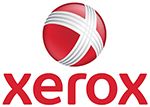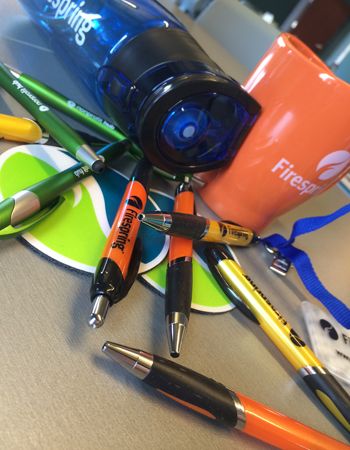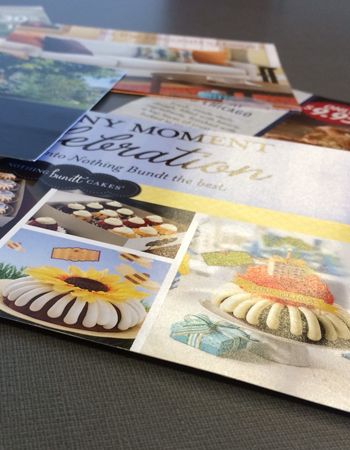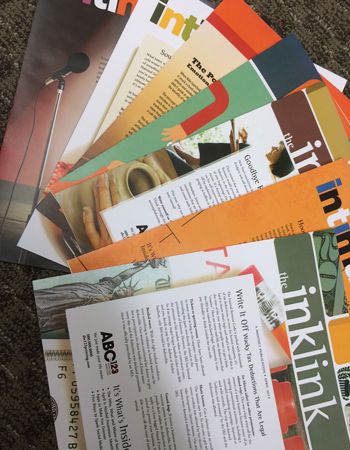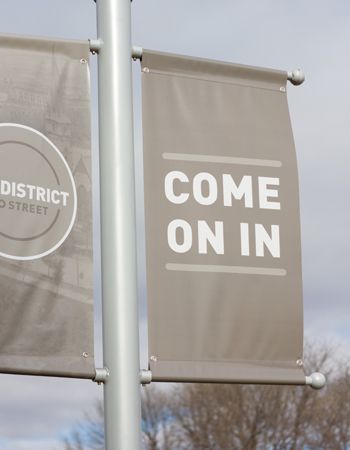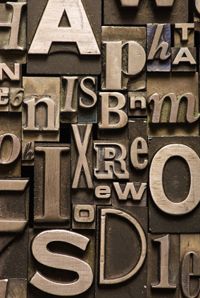
Every industry has its own vocabulary. In case you come across some that are unfamiliar to you, here is some common terminology from the printing industry:
-
Abrasion Resistance
The resistance to scratching of a surface of paper by other paper surfaces or other materials.
-
Accordion Fold
A type of paper folding in which each fold runs in the opposite direction to the previous fold creating a pleated or accordion effect.
-
Acetate
A transparent or translucent plastic sheet material of a variety of colors, used as a basis for artwork and overlays.
-
Achromatic
The non-colors... black, white and gray.
-
Additive Colors
In display reproduction (monitors, stage lighting, etc.) the primary colors of red, green and blue are mixed to form all other colors.
-
Aerate
This refers to a manual process whereby an air stream is blown onto paper sheets to create a riffling effect that separates the sheets as they are fed to the printing press.
-
Agate
A type size of 5 1/2 points. Reference, agate line.
-
Agate Line
In newspaper classifieds, a measurement denoting 1/4 inch depth by one column width. 14 agate lines = one column inch.
-
Air
Large white areas in a design layout.
-
Airbrush
A compressed air tool that dispenses a fine mist of paint or ink; used in illustration and photo retouching.
-
Alignment
The condition of type and or art materials as they level up on a horizontal or vertical line.
-
Alley
A term for a random, coincidental path or a row of white space within a segment of copy.
-
Alphabet Length
The measured length (in points) of the lowercase alphabet of a certain size and series of type.
-
Antigua
An eleventh century Italian script typeface.
-
Antique Finish
Paper with a rough, sized surface used for book and cover stock.
-
Apron
The white area of text (or illustrations) at the margins which form a foldout.
-
Arms
Those elements of letters that branch out from the stem of a letter, such as: "K" and "Y".
-
Arrowhead
A symbol shaped like an arrowhead that is used in illustration to direct a leader line. Reference, leader line
-
Art Work
Any materials or images that are prepared for graphic reproduction.
-
Artwork
All illustrated material, ornamentation, photos and charts etc., that is prepared for reproduction.
-
Ascender
Any part of a lower case letter which rises above the main body of the letter such as in "d", "b" and "h".
-
BF
An abbreviation for boldface, used to determine where boldface copy is to be used. Reference, boldface.
-
Back To Back
Print applied to both sides of a sheet of paper.
-
Backbone
That portion of the binding, which connects the front of the book with the back of the book; also called "back".
-
Background
That portion of a photograph or line art drawing that appears furthest from the eye; the surface upon which the main image is superimposed.
-
Backslant
Any type that tilts to the left or backward direction; opposite of italic type.
-
Backstep Marks
Marks printed on signatures that indicate where the final fold will occur. When gathering and initial folding is completed, these marks appear as a stepped sequence.
-
Balance
A term used to describe the aesthetic or harmony of elements, whether they are photos, art or copy, within a layout or design.
-
Balloon
In an illustration, any line which encircles copy, or dialogue.
-
Banner
The primary headline usually spanning the entire width of a page.
-
Bas Relief
A three dimensional impression is which the image stands just slightly out from the flat background. References, blind emboss.
-
Base Line
This is a term used to describe the imaginary horizontal line upon which stand capitals, lower case letters, punctuation points etc.
-
Basic Size
This term refers to a standard size of paper stock; even though the required size may be smaller or larger.
-
Bauhaus
A design school in Germany where the Sans Serif font was originated.
-
Bearoff
The adjusting of spacing of type in order to correct the justification.
-
Bible Paper
A thin but strong paper (opaque), used for Bibles and books.
-
Binding
Various methods of securing folded sections together and or fastening them to a cover, to form single copies of a book.
-
Black Letter
An old style of typeface used in Germany in the 15th century, also referred to as Old English (US) and Gothic (UK).
-
Bleed
Extra ink area that crosses trim line, used to allow for variations that occur when the reproduction is trimmed or die-cut. Industry standard bleed is 1/8" beyond the trim line.
-
Blind Emboss
A design or bas relief impression that is made without using inks or metal foils.
-
Blind Folio
Page number not printed on page.
-
Blow-up
Any enlargement of photos, copies or line art.
-
Body
The main shank or portion of the letter character other than the ascenders and descenders. Also: A term used to define the thickness or viscosity of printer's ink.
-
Body Size
The point size of a particular type character.
-
Boiler Plate
Repetitive blocks of type that are picked up and included routinely without recreating them.
-
Boldface
Any type that has a heavier black stroke that makes it more conspicuous.
-
Bolts
The edges of folded sheets of paper, which are trimmed off in the final stages of production.
-
Bond
A grade of durable writing, printing and typing paper that has a standard size of 17x22 inches.
-
Book
A general classification to describe papers used to print books; its standard size is 25x38 inches. A printed work which contains more than 64 pages.
-
Brace
A character " }" used to group lines, or phrases.
-
Brochure
A pamphlet that is bound in booklet form.
-
Buckle Folder
A portion of the binding machinery with rollers that fold the paper.
-
Bulk
A term used to define the number of pages per inch of a book relative to its given basis weight.
-
Bulk
A term given to paper to describe its thickness relative to its weight.
-
Bullet
A boldface square or dot used before a sentence to emphasize its importance.
-
CMYK color model
The CMYK color model (process color, four color) is a subtractive color model, used in color printing, and is also used to describe the printing process itself. CMYK refers to the four inks used in some color printing: cyan, magenta, yellow, and key (black). Though it varies by print house, press operator, press manufacturer, and press run, ink is typically applied in the order of the abbreviation.
The "K" in CMYK stands for key because in four-color printing, cyan, magenta, and yellow printing plates are carefully keyed, or aligned, with the key of the black key plate. The CMYK model works by partially or entirely masking colors on a lighter, usually white, background. The ink reduces the light that would otherwise be reflected. Such a model is called subtractive because inks "subtract" brightness from white.
In additive color models such as RGB, white is the "additive" combination of all primary colored lights, while black is the absence of light. In the CMYK model, it is the opposite: white is the natural color of the paper or other background, while black results from a full combination of colored inks. To save money on ink, and to produce deeper black tones, unsaturated and dark colors are produced by using black ink instead of the combination of cyan, magenta and yellow.
-
Caliper
The measurement of thickness of paper expressed in thousandths of an inch or mils.
-
Camera Ready
A term given to any copy, artwork etc., that is prepared for photographic reproduction.
-
Canvas Board
A paperboard with a surface of simulated canvas, used for painting.
-
Cap Line
An imaginary horizontal line running across the tops of capital letters.
-
Caps & Lower Case
Instructions in the typesetting process that indicate the use of a capital letter to start a sentence and the rest of the letters in lower case.
-
Caps & Small Caps
Two sizes of capital letters made in one size of type.
-
Chancery Italic
A 13th century handwriting style which is the roots of italic design.
-
Coarse Screen
Halftone screens commonly used in newsprint; up to 85 lines per inch.
-
Coated (Paper)
Paper coated with clay, white pigments and a binder. Better for printing because there is less picking.
-
Coated Art Paper
Printing papers used for printing projects that require a special treatment of detail and shading.
-
Coated Stock
Any paper that has a mineral coating applied after the paper is made, giving the paper a smoother finish.
-
Cold Color
Any color that moves toward the blue side in the color spectrum.
-
Collate
To gather sheets or signatures together in their correct order. (see Gather)
-
Collating Marks
Black step-marks printed on the back of folded sheets, to facilitate collating and checking of the sequence of book signatures.
-
Collating Marks
Black step-marks printed on the back of folded sheets, to facilitate collating and checking of the sequence of book signatures.
-
Colophon
A printers or publishers identifying symbol or emblem.
-
Color Bars
This term refers to a color test strip, which is printed on the waste portion of a press sheet. It is a standardized (GATF-Graphic Arts Technical Foundation) process which allows a pressman to determine the quality of the printed material relative to ink density, registration, and dot gain. It also includes the Star Target, which is a similar system designed to detect inking problems.
-
Color Separating
The processes of separating the primary color components for printing.
-
Column Gutter
Space between two or more columns of type on one page.
-
Composition
The assembly of characters into words, lines and paragraphs of text or body matter for reproduction by printing.
-
Condensed Type
A narrow, elongated type face.
-
Contrast
The degree of tonal separation or gradation in the range from black to white.
-
Contre Jour
Taking a picture with the camera lens facing the light source.
-
Copy
Refers to any typewritten material, art, photos etc., to be used for the printing process.
-
Copyboard
A board upon which the copy is pasted for the purpose of photographing.
-
Corner Marks
Marks on a final printed sheet that indicate the trim lines or register indicators.
-
Cover
A term describing a general type of papers used for the covers of books, pamphlets etc.
-
Cracking
Delamination.
-
Creep
When the rubber blanket on a cylinder moves forward due to contact with the plate or paper. Result of added thickness of folded sheets being behind one another in a folded signature. Outer edges of sheets creep away from back most fold as more folded sheets are inserted inside the middle.
-
Crop
To eliminate a portion of the art or copy as indicated by crop marks.
-
Crop Mark
Markings at edges of original or on guide sheet to indicate the area desired in reproduction with negative or plate trimmed (cropped) at the markings.
-
Cross-over
Elements that cross page boundaries and land on two consecutive pages (usually rules).
-
Crossmarks
Marks of fine lines, which intersect to indicate accurate alignment of art elements.
-
Crossover
A term used to describe the effect of ink from an image, rule or line art on one printed page, which carries over to another page of a bound work.
-
Curl
Not lying flat and tending to form into cylindrical or wavy shapes. A term to describe the differences of either side of a sheet relative to coatings, absorbency etc.; the concave side is the curl side.
-
Cutter
Machine for accurately cutting stacks of paper to desired dimensions...can also be used to crease. Also trims out final bound books' top size (soft cover).
-
Cutting Die
Sharp edged device, usually made of steel, to cut paper, cardboard, etc., on a printing press.
-
Cyan
A shade of blue used in the four-color process; it reflects blue and green and absorbs red.
-
Delete
An instruction given to remove an element from a layout.
-
Demy
A term that describes a standard sized printing paper measuring 17.5 x 22.5 in.
-
Densitometer
An optical device used by printers and photographers to measure and control the density of color.
-
Density
The lay of paper fibers relative to tightness or looseness which affects the bulk, the absorbency and the finish of the paper.
-
Density
The degree of tone, weight of darkness or color within a photo or reproduction; measurable by the densitometer. Reference, densitometer.
-
Descender
A term that describes that portion of lower case letters which extends below the main body of the letter, as in "p".
-
Die
Design, letters or shapes, cut into metal (mostly brass) for stamping book covers or embossing. An engraved stamp used for impressing an image or design.
-
Die Cutting
A method of using sharp steel ruled stamps or rollers to cut various shapes i.e. labels, boxes, image shapes, either post press or in line. The process of cutting paper in a shape or design by the use of a wooden die or block in which are positioned steel rules in the shape of the desired pattern.
-
Die Stamping
An intaglio process for printing from images engraved into copper or steel plates.
-
Digital Proof
Color separation data is digitally stored and then exposed to color photographic paper creating a picture of the final product before it is actually printed.
-
Diploma
A fine paper made specifically for the printing of diplomas, certificates and documents.
-
Display Type
Any type that stands out from the rest of the type on a page which attracts attention of the reader.
-
Dog Ear
Occurs when you fold into a fold (such as a letter fold). At the side of one of the creases you get an indentation. It may look like a small inverted triangle.
-
Drill
The actual drilling of holes into paper for ring or comb binding.
-
Drop Folio
Page number printed at foot of page.
-
Drop Shadow
A shadow image placed strategically behind an image to create the affect of the image lifting off the page.
-
Dull Finish
Any matte finished paper.
-
Dummy
A term used to describe the preliminary assemblage of copy and art elements to be reproduced in the desired finished product; also called a comp.
-
Duotone
Color reproduction from monochrome original. Keyplate usually printed in dark color for detail, second plate printed in light flat tints. A two-color halftone reproduction generated from a one-color photo.
-
Duplex Paper
Paper which has a different color or finish on each side.
-
Electronic Composition
The assembly of characters into words, lines and paragraphs of text or body matter with graphic elements in page layout form in digital format for reproduction by printing.
-
Electronic Proof
A process of generating a prepress proof in which paper is electronically exposed to the color separation negatives; the paper is passed through the electrically charged pigmented toners, which adhere electrostatically, resulting in the finished proof.
-
Em
A unit of measurement equaling 12 points or 4.5mm.
-
Embossed
A method of paper finishing whereby a pattern is pressed into the paper when it is dry.
-
Embossing
To raise in relief a design or letters already printed on card stock or heavy paper by an uninked block or die. In rubber and plastic plate making the process is usually done by heat.
-
Enamel
A term that describes a glossy coating on paper.
-
Estimate
The form used by the printer to calculate the project for the print buyer. This form contains the basic parameters of the project including size, quantity, colors, bleeds, photos etc.
-
Estimator
One who computes or approximates the cost of work to be done on which quotation may be based.
-
Even Smalls
The use of smaller sized capitals at the beginning of a sentence without the use of larger sized caps.
-
Expanded Type
Type with width greater than normal producing a rectangular effect.
-
F&G
A term in the binding process referring to folding and gathering.
-
Fan Fold
Paper folding that emulates an accordion or fan, the folds being alternating and parallel.
-
Fat Face
Type that is quite varied in its use of very thin and very wide strokes.
-
Finish
The surface quality of paper.
-
Finish (Paper)
Dull - (low gloss) also matte or matte gloss.
-
Fit
The registration of items within a given page.
-
Flush Cover
A bound book or booklet etc. having the cover trimmed to the same size as the text.
-
Foils
Papers that have a surface resembling metal.
-
Fold Marks
Markings at top edges that show where folds should occur.
-
Folder
Machine used to fold signatures down into sections.
-
Folio or Page Number
Number of page at top or bottom either centered, flushed left or flushed right often with running headline.
-
Font
The characters which make up a complete typeface and size.
-
Gather
To assemble or collect sections into single copies of complete books for binding.
-
Gathering
Assembling sheets of paper and signatures into their proper sequence; collating.
-
Gigo
Garbage in, garbage out.
-
Glyphic
A carved as opposed to scripted typeface.
-
Grain
Direction of fibers in a sheet of paper governing paper properties such as increased size changes with relative humidity, across the grain, and better folding properties along the grain.
-
Grained Paper
A paper embossed to resemble various textures, such as leather, alligator, wood, etc.
-
Gripper
A series of metal fingers that hold each sheet of paper as it passes through the various stages of the printing process.
-
Gripper Edge
The grippers of the printing press move the paper through the press by holding onto the leading edge of the sheet; this edge is the gripper edge.
-
Gutter
Space between pages in the printing frame of a book, or inside margin towards the back or binding edge. The blank space or margin between the type page and the binding of a book.
-
Hairline register
Printing registration that lies within the range of plus or minus one half row of dots. It is the thinnest of the standard printers' rules.
-
Head Margin
That space which lies between the top of the printed copy and the trimmed edge.
-
House Sheet
This is a term that refers to a paper that a printer keeps on hand in his shop.
-
IBC
Inside back cover.
-
IFC
Inside front cover.
-
Image Area
That portion of the printing plate that carries the ink and prints on paper.
-
Image Setter
High resolution, large format device for producing film from electronically generated page layouts.
-
Imposition
Arrangement of pages so that they print correctly on a press sheet, and the pages are in proper order when the sheets are folded.
-
Index Bristol
A relatively thick paper stock; basis size---25 1/2 x 30 1/2.
-
Indicia
Markings pre-printed on mailing envelopes to replace the stamp.
-
Inserts
Extra printed pages inserted loosely into printed pieces.
-
Interleaves
Extra blank pages inserted loosely into book after printing.
-
Iridescent Paper
A coated stock finished in mother-of-pearl.
-
Italic
Text that is used to denote emphasis by slanting the type body forward.
-
Jacket
The paper cover sometimes called the "dust cover" of a hardbound book.
-
Job Number
A number assigned to a printing project used for record keeping and job tracking. Also used to retrieve old jobs for reprints or reworking by customer.
-
Jog
To vibrate a stack of finished pages so that they are tightly aligned for final trimming.
-
Jogger
Vibrating, sloping platform that evens up the edges of stacks of paper.
-
Kerning
The narrowing of space between two letters so that they become closer and take up less space on the page.
-
Key Plate
The printing plate that is used as a guide for the other plates in the color printing process; it usually has the most detail.
-
Laid Finish
A parallel lined paper that has a handmade look.
-
Lay Edge
Edge of a sheet of paper being fed into a printing press.
-
Layout
A rendition that shows the placement of all the elements, roughs, thumbnails etc., of the final printed piece before it goes to print.
-
Leaders
The dots or dashes used in type to guide the eye from one set of type to the next.
-
Leading
Space between lines of type; the distance in points between one baseline and the next.
-
Ledger Paper
A stiff heavy business paper generally used for keeping records.
-
Letterspacing
The addition of space between typeset letters.
-
Linen
A paper that emulates the look and texture of linen cloth.
-
Logotype
A personalized type or design symbol for a company or product.
-
M weight
The actual weight of 1000 sheets of any given size of paper.
-
Machine Coated
Paper that has had a coating applied to either one or two of its sides during the papermaking process.
-
Magenta
A purplish-red, purplish-crimson, or purplish-pink color. It is a primary color in color printing which, combined with cyan, yellow, and black in various combinations, can be used to create all other colors. The name comes from the dye magenta, originally called fuchsine, discovered in 1859, and renamed after the 1859 Battle of Magenta near Magenta, Italy where the French army defeated the Austrians and helped secure the unification of Italy.
-
Margin
Imprinted space around edge of page.
-
Mark-up
To write up instructions, as on a dummy.
-
Measure
The width of type as measured in picas. Reference, picas.
-
Mechanical
A term used to describe finished artwork that is camera ready for reproduction, including all type, photos, illustrations etc.
-
Metropolitan Service Area
A group of ZIP codes usually in close proximity defining a large metropolitan area (e.g. New York City or Los Angeles).
-
Newsprint
A light, low cost groundwood paper made especially for newspapers. Reference, groundwood.
-
OBC
Outside back cover.
-
OFC
Outside front cover.
-
Oblong
A term used to describe printed books, catalogs etc., that are bound on their shorter side; also referred to as album bound.
-
Off-shore Paper
Any papers made outside the US and Canada.
-
Onionskin
A light bond paper used for typing and used with carbon paper because of its thinness.
-
Opacity
Quality of papers that defines its opaqueness or ability to prevent two-sided printing from showing through.
-
Opaque
A quality of paper that allows relatively little light to pass through.
-
Over Run
Surplus of copies printed.
-
Overhang Cover
A cover of a book that extends over the trimmed signatures it contains.
-
Overlay
A transparent sheet placed over artwork, in register with the work it covers; this is used to call out other color components of the work, instructions or corrections.
-
Overprinting
Any printing that is done on an area that has already been printed.
-
Overset
Type that is set in excess of the allotted space.
-
Page
One side of a leaf.
-
Page Makeup
The assemblage of all the necessary elements required to complete a page.
-
Page Proofs
Proofs made up from pages.
-
Paperboard
Any paper with a thickness (caliper) of 12 points (.3mm) or more.
-
Parchment
A hard finished paper that emulates animal skin; used for documents, such as awards, that require writing by hand.
-
Parent Sheet
A sheet that is larger than the cut stock of the same paper.
-
Perf Marks
Markings usually dotted lines at edges showing where perforations should occur.
-
Perfect Binding
Binding process where backs of sections are cut off, roughened and glued together, and rung in a cover.
-
Perfecting
Printing both sides of the paper (or other material) on the same pass through the printing machine.
-
Perforating
Punching small holes or slits in a sheet of paper or cardboard to facilitate tearing along a desired line.
-
Pica
Standard of measurement, 1/6 inch. 1 pica = 12 points 72 points = 1 inch
-
Plastic Comb
A method of binding books whereby holes are drilled on the side closest the spine, and a plastic grasping device is inserted to hold the pages together.
-
Point
A measurement unit equal to 1/72 of an inch. 12 points to a pica, 72 points to an inch.
-
Ppi
Pixels per inch.
-
Primary Colors
In printing the four primary colors are cyan (blue), magenta (red), yellow and black.
-
Printers Pairs
Two consecutive pages as they appear on a flat or signature.
-
Process Inks
Printing inks, usually in sets of four colors. The most frequent combination is yellow, magenta, cyan, and black, which are printed, one over another in that order, to obtain a colored print with the desired hues, whites, blacks, and grays.
-
Proof
Impression from composed type or blocks, taken for checking and correction, from a lithographic plate to check accuracy of layout, type matter, tone and color reproduction.
-
RGB color model
The RGB color model is an additive color model in which red, green, and blue light are added together in various ways to reproduce a broad array of colors. The name of the model comes from the initials of the three additive primary colors, red, green, and blue.
The main purpose of the RGB color model is for the sensing, representation, and display of images in electronic systems, such as televisions and computers, though it has also been used in conventional photography. Before the electronic age, the RGB color model already had a solid theory behind it, based in human perception of colors.
RGB is a device-dependent color model: different devices detect or reproduce a given RGB value differently, since the color elements (such as phosphors or dyes) and their response to the individual R, G, and B levels vary from manufacturer to manufacturer, or even in the same device over time. Thus an RGB value does not define the same color across devices without some kind of color management.
Typical RGB input devices are color TV and video cameras, image scanners, and digital cameras. Typical RGB output devices are TV sets of various technologies (CRT, LCD, plasma, etc.), computer and mobile phone displays, video projectors, multicolor LED displays, and large screens such as JumboTron.
Color printers, on the other hand, are not RGB devices, but subtractive color devices (typically CMYK color model).
-
Ragged Left
The term given to right-justified type that is uneven on the left.
-
Ragged Right
The term given to left-justified type that is uneven on the right.
-
Readers Pairs
Two consecutive pages as they appear in printed piece.
-
Ream
500 sheets of paper.
-
Recto
The odd numbered pages (right hand side) of books.
-
Register
The arrangement of two or more images in exact alignment with each other.
-
Register Marks
Any crossmarks or other symbols used on layout to assure proper registration.
-
Right Angle Fold
A term that denotes folds that are 90 degrees to each other.
-
Run-Around
A term given to copy that accommodates the lines of a picture or other image or copy.
-
Running Head
A title at the top of a page that appears on all pages of a book or chapter of a book.
-
Saddle Stitching
Stitching where the wire staples pass through the spine from the outside and are clinched in the center. Only used with folded sections, either single sections or two or more sections inset to form a single section.
-
Safety Paper
A paper that shows sign of erasure so that it cannot be altered or tampered with easily.
-
Satin Finish
A smooth delicately embossed finished paper with sheen.
-
Scaling
The enlargement or reduction of an image or copy to fit a specific area.
-
Score
Impressions or cuts in flat material to facilitate bending or tearing.
-
Self Cover
A cover made out of the same paper stock as the internal sheets.
-
Sharpen
To decrease the dot size of the halftone which in turn decreases the color strength.
-
Show Through
A problem that occurs when the printing on one side of a sheet is seen from the other side.
-
Side Stitching
Stitching where the wire staples pass through the pile of sections or leaves gathered upon each other and are clinched on the underside.
-
Signature (Section)
Printed sheet (or its flat) that consists of a number of pages of a book, placed so that they will fold and bind together as a section of a book. The printed sheet after folding.
-
Smoothness
That quality of paper defined by its levelness which allows for pressure consistency in printing, assuring uniformity of print.
-
Spine
Back edge of a book.
-
Spiral Bind
A binding whereby a wire or plastic is spiraled through holes punched along the binding side.
-
Spot Color
Small area printed in a second color.
-
Spread
A film image that is larger than the original image to accommodate ink trapping. Reference, trapping
-
Stability
The quality of paper to maintain its original size when it undergoes pressure and moisture changes.
-
Star Target
The Graphic Arts Technical Foundation, GATF has established various quality control images; the star target appears along with the color bar and helps the pressman detect any irregularity in the ink spread. Reference, Color Bars
-
Step And Repeat
A process of generating multiple exposures by taking an image and stepping it according to a predetermined layout. It is best to give your printer a 'one-up' image and they will step and repeat it the most efficient way on the material that has been selected.
-
Stet
A proofreader's symbol that is usually written in the copy margin, that indicates that the copy, which was marked for correction, should be left as it was.
-
Stock
A term for unprinted paper or other material to be printed.
-
Subtractive color
A subtractive color model explains the mixing of a limited set of dyes, inks, paint pigments or natural colorants to create a wider range of colors, each the result of partially or completely subtracting (that is, absorbing) some wavelengths of light and not others. The color that a surface displays depends on which parts of the visible spectrum are not absorbed and therefore remain visible.
Subtractive color systems start with light, presumably white light. Colored inks, paints, or filters between the viewer and the light source or reflective surface subtract wavelengths from the light, giving it color. If the incident light is other than white, our visual mechanisms are able to compensate well, but not perfectly, often giving a flawed impression of the "true" color of the surface. Paper color will also have an affect on perceived color
-
Synthetic Papers
Any petroleum based waterproof papers with a high tensile strength.
-
Tensile Strength
A paper's ability to withstand pressure.
-
Text
A high quality printing paper.
-
Trim Marks
Marks placed on the sheet to indicate where to cut the page. Also called crop marks.
-
Up
A term used to describe how many similar sheets can be produced on a larger sheet; two up, four up, etc.
-
Vellum
A finish of paper that is rough, bulky and has a degree of tooth.
-
Velour Paper
A term given to papers that are coated with an adhesive and then flock dusted.
-
Verso
A term given to the left-hand or even-numbered pages of a book.
-
Vignette
Fade to white or small decorative design or illustration. A photo or illustration etc., in which the tones fade gradually away until they blend with the surface they are printed on.
-
W&B
An abbreviation for work and back. Reference, sheetwise.
-
W&T
An abbreviation for work and turn.
-
Watermark
A translucent logo that is embossed during the papermaking process while the paper slurry is on the dandy roll. Reference, dandy roll
-
Web Press
Cylinder printing machine in which the paper is fed from a continuous reel, as opposed to sheet fed.
-
Widow
A single word or two left at the end of a paragraph, or a part of a sentence ending a paragraph, which loops over to the next page and stands alone. Also, the last sentence of a paragraph which contains only one or two short words.
-
Wire Stitching Or Stapling
To fasten together sheets, signatures, or sections with wire staples. 3 methods... saddle stitching, side stitching, and stabbing.
-
Wove
A smooth paper made on finely textured wire that gives the paper a gentle patterned finish.
-
Wrinkles
The unevenly dried surface of printed inks.
-
Xerographic Paper
Papers made to reproduce well in copy machines and laser printers.
-
Yellow
Process yellow (also known as pigment yellow, printer's yellow or canary yellow) is one of the three colors typically used as subtractive primary colors, along with magenta and cyan. The CMYK system for color printing is based on using four inks, one of which is a yellow color. This is in itself a standard color, and a fairly narrow range of yellow inks or pigments are used. Process yellow is based on a colorant that reflects the preponderance of red and green light, and absorbs most blue light, as in the reflectance spectra shown in the figure on the lower right.
Because of the characteristics of paint pigments and use of different color wheels, painters traditionally regard the complement of yellow as the color indigo or blue-violet.
Process yellow is not an RGB color, and there is no fixed conversion from CMYK primaries to RGB. Different formulations are used for printer's ink, so there can be variations in the printed color that is pure yellow ink.
The first recorded use of canary yellow as a color name in English was in 1789.

